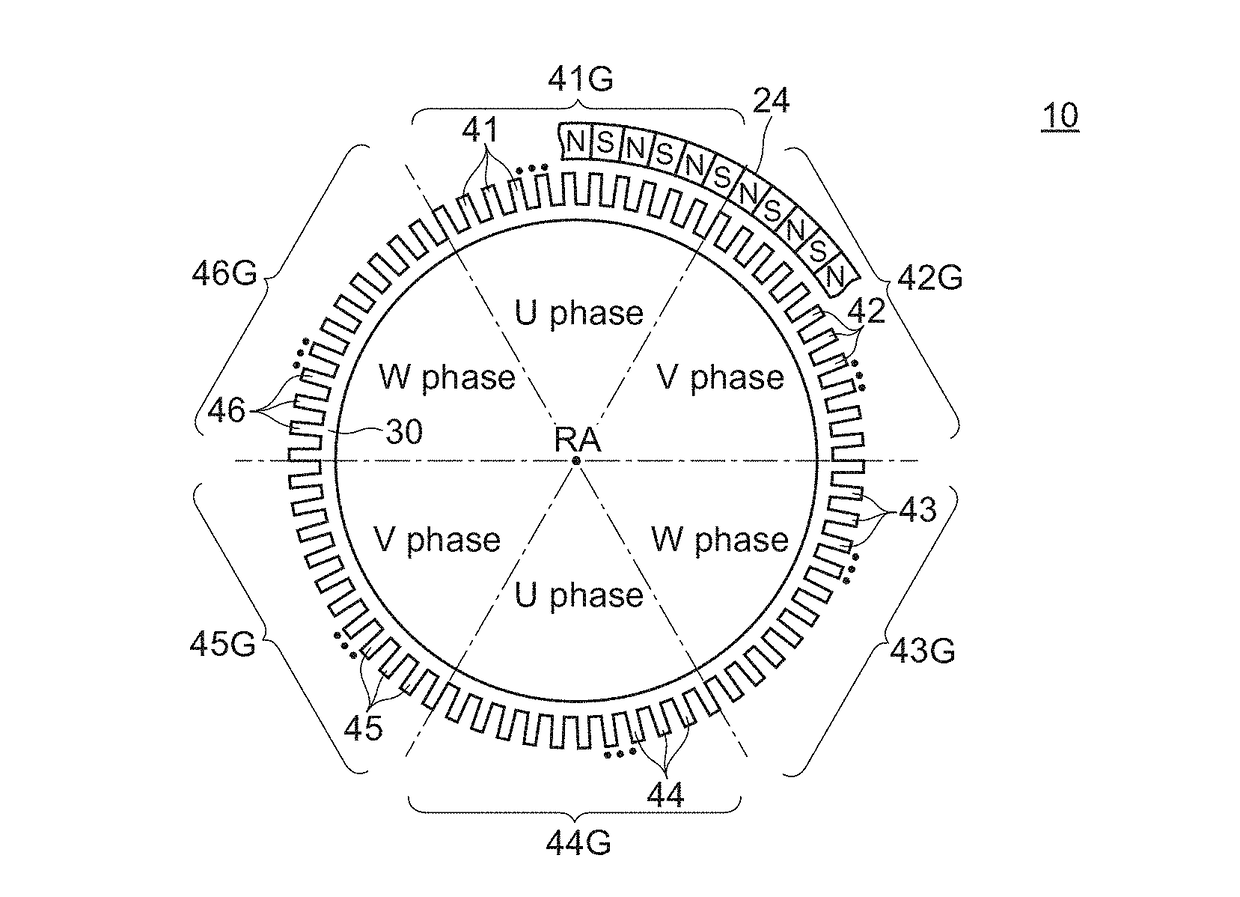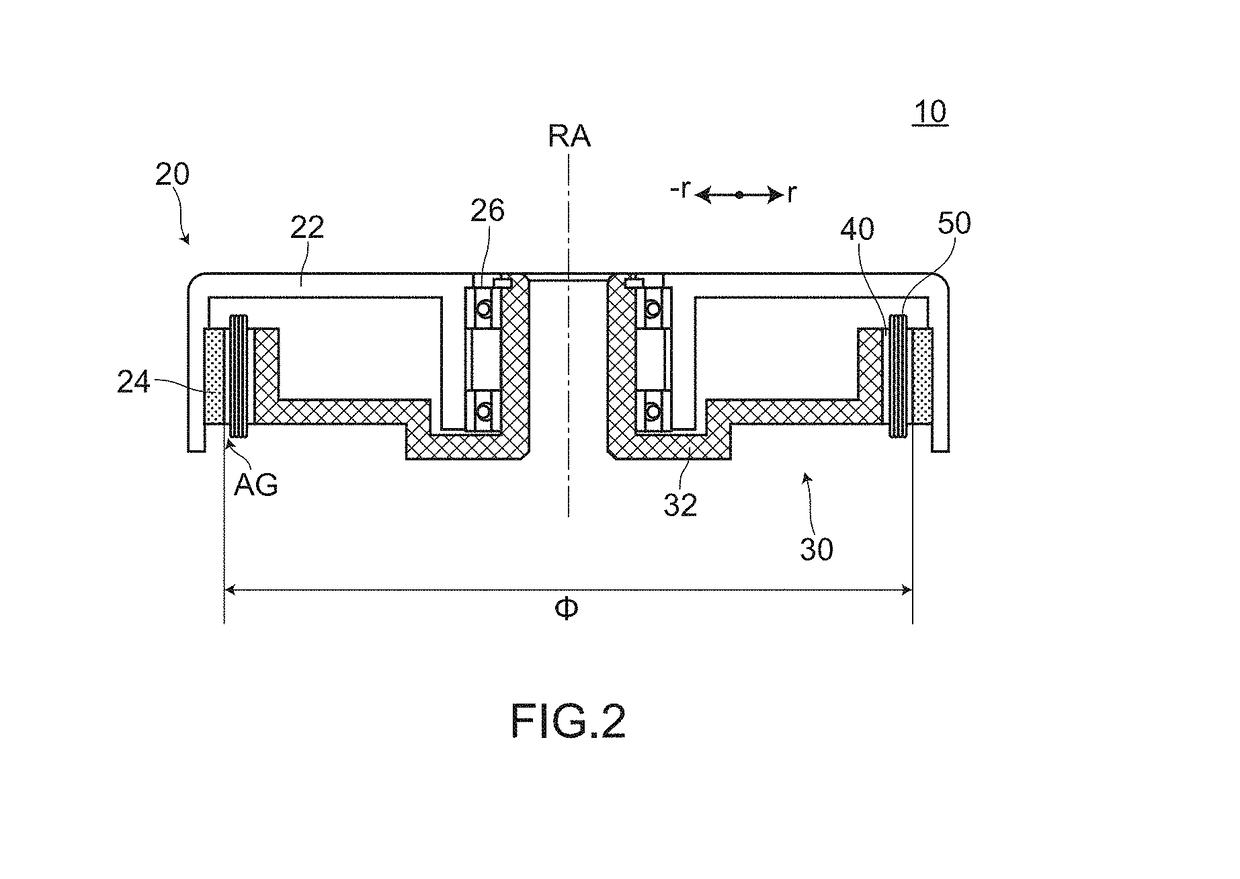Motor and method of manufacturing motor
a manufacturing method and motor technology, applied in the direction of manufacturing stator/rotor body, magnetic circuit rotating parts, shape/form/construction, etc., can solve the problems of increasing the number of parts, increasing the number of noise generation, and increasing the energy loss of the reduction gear or the generation of noise, etc., to achieve smooth and stable rotation, reduce vibration and/or noise, and high torque
- Summary
- Abstract
- Description
- Claims
- Application Information
AI Technical Summary
Benefits of technology
Problems solved by technology
Method used
Image
Examples
embodiment 1
1. Basic Structure of Motor 10 According to Embodiment 1
[0062]FIG. 1A to FIG. 1C, FIG. 2, FIG. 3A to FIG. 3B and FIG. 4A to FIG. 4B are views for describing a motor 10 according to an embodiment 1. FIG. 1A is a perspective view showing a state where the motor 10 is disassembled. FIG. 1B and FIG. 1C are perspective views showing a state where a rotor 20 and a stator 30 are assembled to each other. FIG. 2 is a cross-sectional view of the motor 10 taken along a plane A-A in FIG. 1C. FIG. 3A is a view showing an arrangement of salient poles 40 when the motor 10 is viewed in a plan view along a rotary axis RA. In FIG. 3A, a part of the permanent magnet 24 is also shown. Further, boundaries each of which is formed between each two salient pole groups among first salient pole group 41G to sixth salient pole group 46G are indicated by a dotted chain line respectively for the sake of convenience. FIG. 3B is a view showing the first salient pole group 41G, a first coil group 51G, and the perm...
embodiment 2
[0137]Hereinafter, a motor 12 according to an embodiment 2 is described.
[0138]FIG. 10 is a view for describing an arrangement relationship between salient poles 40 and a permanent magnet 24 of the motor 12 according to the embodiment 2. Boundaries between a first salient pole group 41G to a twelfth salient pole group 412G are indicated by a chained line for the sake of convenience. In FIG. 10, the description is made mainly with respect to the salient poles 40 and the permanent magnet 24, and the description of other constitutional elements such as coils is omitted.
[0139]Although the motor 12 according to the embodiment 2 basically has substantially the same configuration as the motor 10 of the embodiment 1, the motor 12 according to the embodiment 2 differs from the motor 10 according to the embodiment 1 with respect to the number of salient poles, the number of coils and the like. That is, as shown in FIG. 10, the motor 12 according to the embodiment 2 includes twelve salient pole...
embodiment 3
[0164]Hereinafter, a motor 13 according to an embodiment 3 is described.
[0165]FIG. 13 is a view for describing an arrangement relationship between salient poles 40 and a permanent magnet 24 of the motor 13 according to the embodiment 3. Boundaries between a first salient pole group 41G to a ninth salient pole group 49G are indicated by a chained line for the sake of convenience. In FIG. 13, the description is made mainly with respect to the salient poles 40 and the permanent magnet 24, and the description of other constitutional elements such as coils is omitted.
1. Configuration of Motor 13 According to Embodiment 3
[0166]Although the motor 13 according to the embodiment 3 basically has substantially the same configuration as the motor 12 according to the embodiment 2, the motor 13 according to the embodiment 3 differs from the motor 12 according to the embodiment 2 with respect to the number of salient pole groups, the number of coil groups and the like. That is, as shown in FIG. 13...
PUM
 Login to View More
Login to View More Abstract
Description
Claims
Application Information
 Login to View More
Login to View More - R&D
- Intellectual Property
- Life Sciences
- Materials
- Tech Scout
- Unparalleled Data Quality
- Higher Quality Content
- 60% Fewer Hallucinations
Browse by: Latest US Patents, China's latest patents, Technical Efficacy Thesaurus, Application Domain, Technology Topic, Popular Technical Reports.
© 2025 PatSnap. All rights reserved.Legal|Privacy policy|Modern Slavery Act Transparency Statement|Sitemap|About US| Contact US: help@patsnap.com



